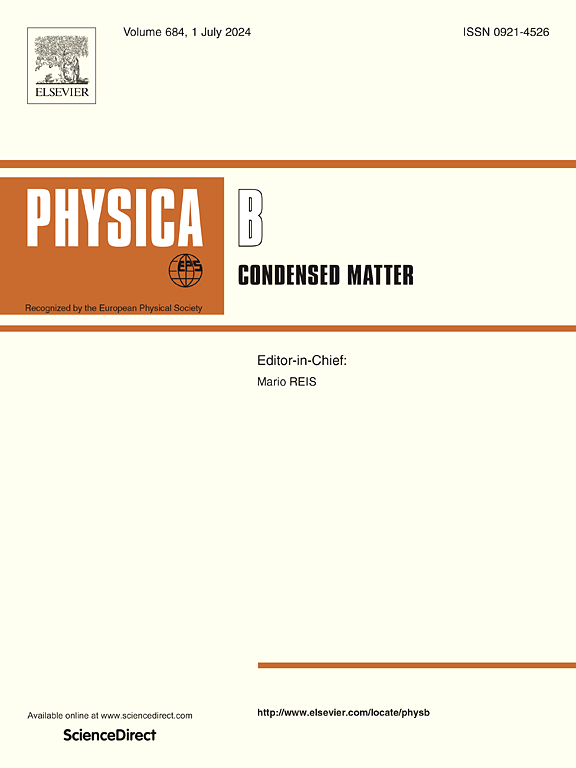Multifunctional optical thermometry based on La2MgSnO6:Mn4+, M (M=Bi3+, Sm3+) double perovskite phosphors
IF 2.8
3区 物理与天体物理
Q2 PHYSICS, CONDENSED MATTER
引用次数: 0
Abstract
To develop novel luminescent materials for optical thermometry, a series of La2MgSnO6:Mn4+, M (M = Bi3+, Sm3+) phosphors were prepared by the solid-state method. Upon UV excitation, the La2MgSnO6: Mn4+ sample demonstrates strong red emission originating from the 2Eg → 4A2g transition of Mn4+. By co-doping with Bi3+ or Sm3+, it becomes possible to achieve tunable emission in La2MgSnO6 phosphors. Due to the different thermal quenching behavior between the Mn4+ and Bi3+ or Sm3+, a high-sensitivity thermometric was developed using the fluorescence intensity ratio mode. The maximum sensitivity was obtained to 1.5 %K−1 at 473K. The emission spectra of La2MgSnO6: Mn4+, M (M = Bi3+, Sm3+) phosphor significantly coincide with the absorption spectra of plant pigments in the blue and red regions. These findings indicate that the as-prepared La2MgSnO6: Mn4+, M (M = Bi3+, Sm3+) phosphors are promising candidate materials for plant cultivation and high-temperature optical thermometry.
基于La2MgSnO6:Mn4+, M (M=Bi3+, Sm3+)双钙钛矿荧光粉的多功能光学测温
为了开发用于光学测温的新型发光材料,采用固态法制备了La2MgSnO6:Mn4+, M (M = Bi3+, Sm3+)荧光粉。在紫外激发下,La2MgSnO6: Mn4+样品显示出由Mn4+的2Eg→4A2g跃迁引起的强红色发射。通过与Bi3+或Sm3+共掺杂,可以在La2MgSnO6荧光粉中实现可调谐发射。由于Mn4+与Bi3+或Sm3+的热猝灭行为不同,采用荧光强度比模式开发了一种高灵敏度的测温方法。在473K时,最大灵敏度为1.5% K−1。La2MgSnO6: Mn4+, M (M = Bi3+, Sm3+)荧光粉的发射光谱与植物色素在蓝色和红色区域的吸收光谱有明显的重合。这些结果表明,制备的La2MgSnO6: Mn4+, M (M = Bi3+, Sm3+)荧光粉是植物栽培和高温光学测温的理想候选材料。
本文章由计算机程序翻译,如有差异,请以英文原文为准。
求助全文
约1分钟内获得全文
求助全文
来源期刊

Physica B-condensed Matter
物理-物理:凝聚态物理
CiteScore
4.90
自引率
7.10%
发文量
703
审稿时长
44 days
期刊介绍:
Physica B: Condensed Matter comprises all condensed matter and material physics that involve theoretical, computational and experimental work.
Papers should contain further developments and a proper discussion on the physics of experimental or theoretical results in one of the following areas:
-Magnetism
-Materials physics
-Nanostructures and nanomaterials
-Optics and optical materials
-Quantum materials
-Semiconductors
-Strongly correlated systems
-Superconductivity
-Surfaces and interfaces
 求助内容:
求助内容: 应助结果提醒方式:
应助结果提醒方式:


